Indoor Palm Plants: Types and Care – Types of Indoor Palm Trees to Grow as Houseplants (With Pictures)

Indoor palm plants are excellent for bringing some of the tropics into your home. Most types of palm houseplants have arching fronds with thin pointed leaflets on each stem. Growing indoor palms can improve the aesthetics of any room in your house or office. Even though they have some specific care requirements, growing palms indoors in attractive pots is relatively straightforward.
The most popular types of indoor palm plants are majesty (majestic) palms, parlor palms, areca palms, cat palms, and kentia palms. People love these well-known palm houseplants because they don’t take up a lot of room. Common indoor palm trees brighten up any corner or living space with their elegant foliage.
How to care for indoor palm plants: Place the potted palm plant in a bright location, with indirect sunlight, and in well-draining potting soil. Indoor palm trees thrive when soil is moist—never too soggy or too dry. Water the palm plant when the top part of the soil has dried. Fertilize occasionally, keep humidity levels high, and in average room temperature.
Brown leaf tips are the most common care issue with indoor palm trees. To avoid brown tips developing on the fronds, don’t over-fertilize your palm plant, keep the soil moist, and increase room humidity. Most websites advise pruning the brown tips of palm leaves; however it can cause the whole frond to die. You should prune the whole leaf if it’s dead and turned brown.
In this article, you will learn about the most popular varieties of palms. You will also find out about some less well-known indoor palm house plants. At the end of the article, you will find a helpful guide on how to care for your exotic, tropical potted plant.
Indoor Palm Plants (With Pictures of Indoor Palm Trees)
Continue reading to learn how to identify the most common types of indoor palm plants. Along with their scientific names, pictures will assist with palm identification so you can find the perfect house or office plant.
Parlor Palm (Chamaedorea elegans)

The parlor palm is one of the most popular palm plants to grow indoors
The parlor palm is one of the easiest palm species to grow as an indoor houseplant. Because it is so easy to look after, the parlor palm (or, neanthe bella palm) is one of the world’s most popular houseplants. This palm plant also makes it onto the list of houseplants that purify the air. Although the plant grows in shaded light, keep humidity levels high for it to thrive.
Compared to other types of palms, the parlor palm tree can thrive in average indoor light and even some shade. This slow-growing tropical palm has crescent-shaped leaves. As an indoor potted palm plant, the bushy palm will grow to around 6 ft. (1.8 m). However, it may take many years of regular care for the parlor palm to reach its full height.
Related reading: Houseplants for your bedroom and the best shower plants for bathrooms.
Chinese Fan Palm (Livistona chinensis)
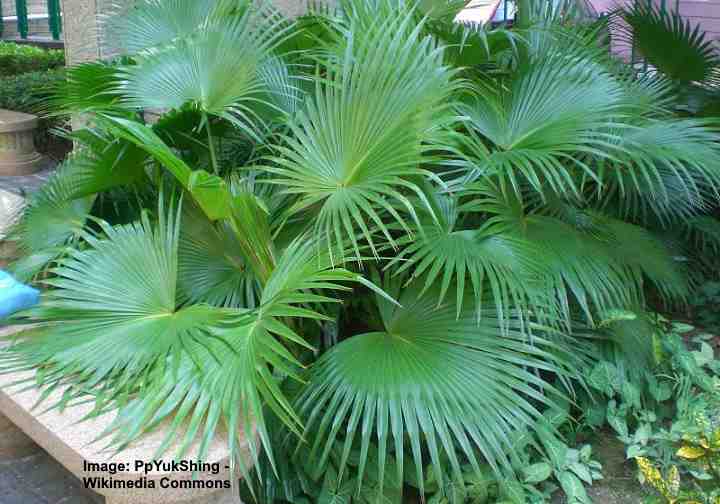
A potted Chinese fan palm can take a lot of space at home or in the office
One of the coolest and most unique-looking indoor plants is the Chinese Fan palm (also named fountain palm). Looking at pictures of this tropical palm, it’s easy to see why it’s named as a type of fan palm plant. The frond leaves are dark green and in the shape of a star that look elegant in any sunny room.
As with most types of indoor palm plants, the Chinese fan palm is a slow grower. Eventually, the evergreen tropical palm should reach a height of 10 ft. (3 m). It also has a wide spread, so give the plant plenty of space in a bright, airy room. Keep the potted palm plant in temperatures between 70°F and 80°F (21°C – 27°C) and out of drafts for it to thrive.
Areca Palm (Dypsis lutescens)
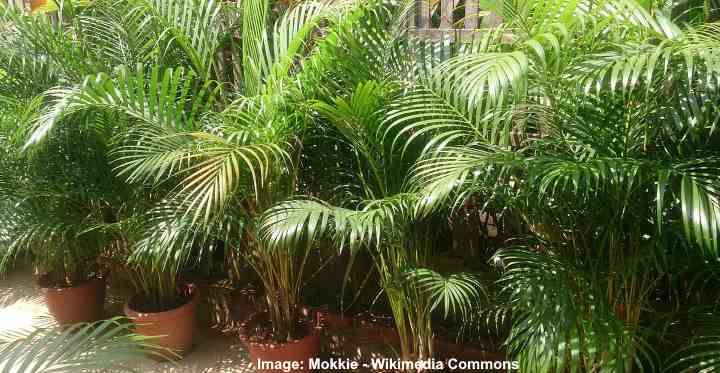
Areca palm is a type of indoor palm plant that will give a tropical look to any space
As an indoor potted palm plant, the areca palm grows in clumps, and the thin arching leaves look like palm grass. Like most palm plants that grow indoors, the areca palm needs a bright, sunny location, away from direct sunlight. One challenge of having an areca palm indoors is that fertilizer salts tend to build up in the soil. So, only feed once or twice in the growing season and flush the soil occasionally.
Another name for the areca palm is the butterfly palm due to its feathery, arched fronds that look like a butterfly. Other common names for the areca palm include golden cane palm or yellow palm. The long thin stems and green foliage make this palm look similar to bamboo.
Cat Palm (Chamaedorea cataractarum)
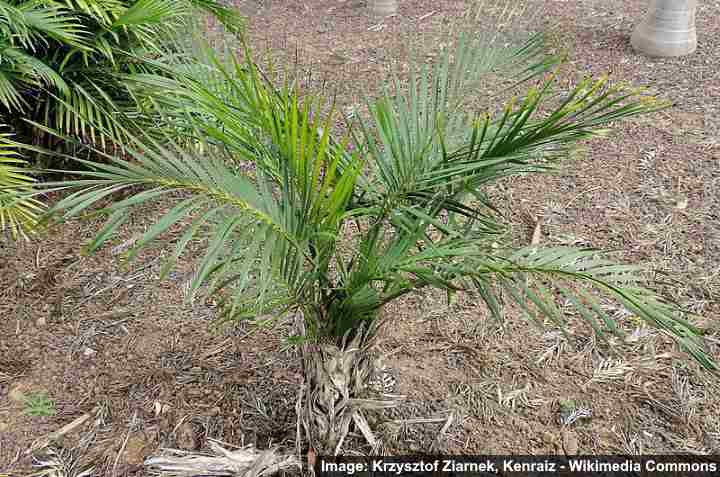
Cat palm (cascade palm) is a type of small indoor palm tree
Also called the cascade palm, cat palm plant is a small palm tree suitable for growing indoors in bright light and sunny locations—as long as the sun doesn’t shine directly on the leaves. Scorching is one reason why many palm leaves turn yellow. The foliage of this cat palm is long slender green leaves.
Being a clumping palm, the bushy foliage on the multiple stems of cat palms makes this an excellent palm to brighten up a corner. As an elegant houseplant palm, the cat palm grows up to 3.3 ft. (1 m).
Ponytail Palm (Beaucarnea recurvata)
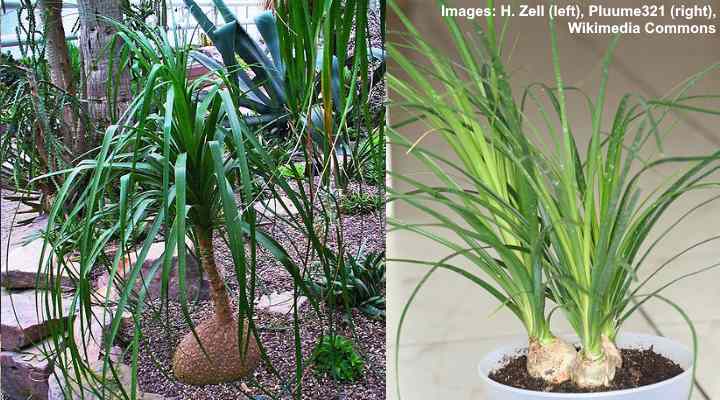
The unique look of the ponytail palm makes it an attractive potted palm tree to grow indoors
Another unusual houseplant palm is the ponytail palm—also called elephant’s foot palm. The crowning leaves sit on the top of a thick trunk or stem. The base of the stem is somewhat larger than the stem and, even in small pots, this palm looks like an elephant’s foot.
The ponytail palm plant grows well in indoor environments and it is also one of the best palm trees to grow in pots outdoors in temperate climates.
The thick base of the trunk stores moisture, making the ponytail palm a drought-resistant plant for growing indoors. The ornamental palm plant doesn’t grow tall when grown in pots. It’s suitable as a tabletop plant or in any room of your house that has light shade and no direct sunlight.
Majestic Palm (Ravenea rivularis)
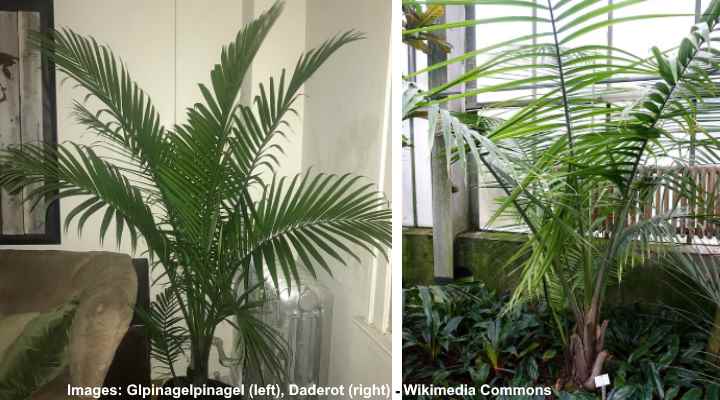
The majestic palm is a slow growing palm plant that requires humidity to grow well
Also called the majesty palm, this indoor palm tree is an excellent plant to cheer up a dim corner of your room. The majesty palm lives up to its common names—truly majestic. Its long arching fronds are one reason why this is on the list of most popular houseplant palms.
Although bright light is a fundamental care requirement for the majesty palm plant, it also grows well in shady locations. Majestic palms require plenty of air moisture, moist soil, and consistent warmth to thrive indoors. Its particular requirements mean that brown tips are common on this palm species. Eventually, the majestic palm will outgrow your room because the palm tree can grow up to 98 ft. (30 m) tall. However, it is a slow-growing palm and will take many years to reach that height.
Bamboo Palm (Chamaedorea seifrizii)

When caring for bamboo palm indoors, make sure to place it in a shady location
The bamboo palm is a decorative palm plant with bushy foliage reminiscent of growing bamboo. Clumps of slender, cane-like stems with leaves grow together, creating dense greenery. In the native environment, bamboo plants grow in the shade. So, these palms will grow in the shade.
When growing in containers indoors, the bamboo palm only grows to two or three feet (60 – 90 cm). This species of small palm tree is related to the parlor palm and shares a common name with the areca palm. The compact growing nature of this palm plant means it’s an ideal choice where space and light are limited.
Kentia Palm (Howea forsteriana)

Kentia Palm is a hardy and easy to care for palm plant
When it comes to choosing an elegant palm tree, it is difficult to beat the kentia palm plant. This ornamental palm has gorgeous green leaves that grow upward and arch slightly. These high-end potted palms also provide a height accent to bring life to a shady corner of a room.
One of the reasons to choose a kentia palm for growing indoors is that it is one of the most shade-tolerant of any of the palms on this list. The easy-to-care-for houseplant is drought-tolerant and doesn’t even mind the cold. Unlike some indoor plant trees, the kentia palm doesn’t grow too large. Keeping the soil moist and the air humid is the best way to prevent browning palm leaf tips.
Lady Palm (Rhapis excelsa)

The low light and humidity requirements of lady palm makes it a common potted palm tree in offices
The outstanding feature of broadleaf lady palm plant is the shiny, dark green fronds and lush growing nature. One distinguishing feature of this palm is the broad palm leaves. Unlike other houseplant palms, the ends of the leaves are not tapered but have saw-toothed ends.
The lady palm is one of the palms that look like bamboo as it’s growing in pots. Similar to Dypsis lutescens (Areca palm) and Chamaedorea seifrizii palms (Bamboo palms), this plant is also sold as a bamboo palm. So, it is always advisable to check the scientific name or look at pictures of the palm for identification.
Fishtail Palm (Caryota mitis)
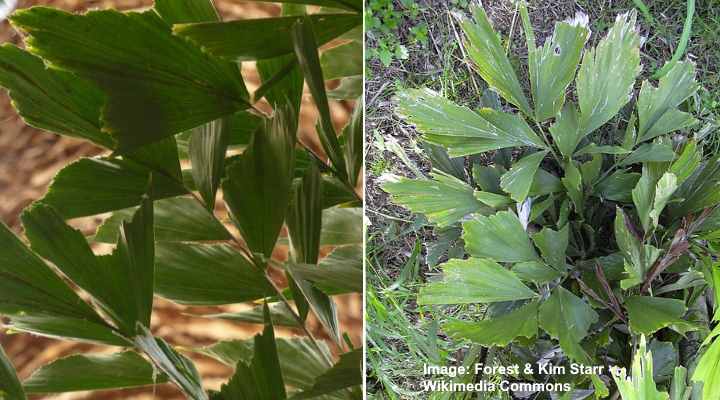
The interesting leaves of the fishtail palm add unique decorative element to any indoor space
It is uncommon to find fishtail palms, but that doesn’t mean they are not gorgeous houseplants. Their uniquely-shaped leaves, interesting texture, and upward growth habits all combine to make this palm houseplant a stunner. As long as it’s kept out of direct sunlight, this palm thrives in bright spots where they get enough humidity.
Fishtail palms grow well indoors in containers. They are easy to grow and don’t have any special requirements that are different from other types of palms. Keep the soil moist, provide deep watering occasionally, and only fertilize every other month to avoid brown tips on the leaves.
Sentry Palm (Howea belmoreana)

Keep sentry palm plant in a smaller pot to restrict its growth indoors
The sentry palm looks similar to the kentia palm with long slender stems and a crown of shiny green foliage. The main difference between the two types of palms is that the sentry palm leaves arch more. If you check their scientific names, you will notice that both are cultivars from the same palm genus Howea.
In their native environment, sentry palms and kentia palms are enormous palm trees. The palm doesn’t grow more than 10 ft. (3 m) when in pots indoors. Keeping the house palm in a small container will restrict growth. It has broad fronds and can help to add a tropical feel to a brightly-lit room, office, hallway, or entrance.
Pygmy Date Palm (Phoenix roebelenii)

The pygmy date is a tropical palm that requires regular misting
As its name suggests, the pygmy palm is a small type of palm suitable for compact, bright spaces. Compared to other indoor tropical palms, the pygmy date palm is easy to care for. This type of palm tree is extremely popular in Florida landscaping.
You will notice in pictures that the pygmy palm’s fronds are narrower than other palms. These fronds arch over in the classic palm-leaf shape. In containers indoors, pygmy palms may only grow to about 4 ft. (1.2 m)—ideal if you don’t have much room.
As with most tropical palms that are suited for indoor growing, keep the potted palm plant in bright, indirect light. Putting the pygmy palm in a corner that gets morning or evening sun will be ideal. Regular misting, watering only when necessary, and occasional feeding should help to prevent browning on the tips.
European Fan Palm (Chamaerops humilis)
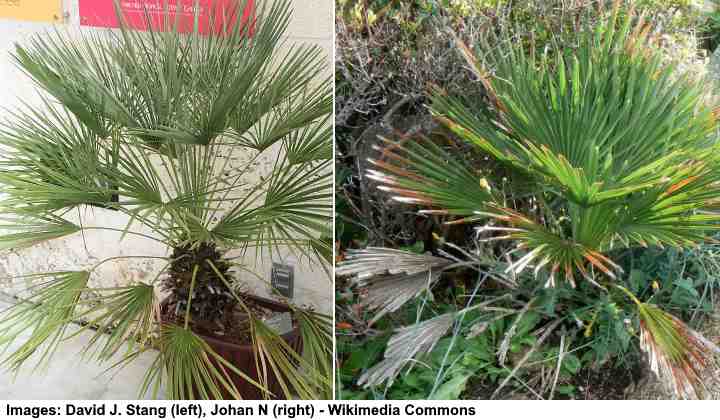
The European fan palm is a slow growing low maintenance indoor palm plant
Similar to the Chinese fan palm, the European fan palm has spiky fronds that grow in a star shape. The European fan palms are easy plants to grow indoors because they grow in a range of temperatures and don’t mind being in some shade. They even thrive in regular room humidity—something that few palms can do.
As a small houseplant, European fan palms are quite manageable. These palms are usually sold when they’re about 1 ft. (30 cm) tall and after a few years will be approximately 3 ft. (90 cm) high. They are slow-growing plants that reach their full height indoors after ten years or so. However, because a mature fan palm has a wide spread, you will need plenty of room for it to grow.
Palm-Looking Plants That Are Not True Palms
Although sago and yucca plants resemble palm plants, they are not true palms. However these palm-looking plants can be a good alternative to true palms and can add aesthetic look to your home or office.
Sago Palm (Cycas revoluta)
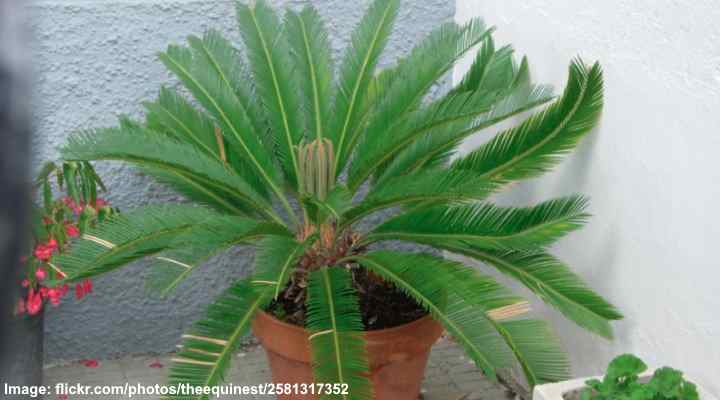
Sago palm needs well draining soil and bright light when grown indoors
The sago palm is a beautiful-looking houseplant to add a touch of exoticism and class to a sunny room. Despite being called a type of palm and looking like a palm, sago palms are cycads belonging to the family Cycadaceae.
The short, plump, fuzzy sago palm trunk looks like a pineapple growing out of the ground. From the thick stem, long, stiff fronds arch out that have leaflets that grow upward.
A sago palm has a lifespan of about 15 years as an indoor palm. To keep your palm healthy and thriving, it’s essential to water it occasionally, keep humidity high, and place it in bright light.
Yucca (Yucca aloifolia)

Yuccas add a dramatic element to any space and tolerate a range of conditions
A yucca plant is an excellent choice if your home or apartment doesn’t get a lot of sunlight, but you need some greenery. Yuccas aren’t palms, but they don’t need as much light as house palm plants require. They thrive in partly shaded locations and can withstand periods of dryness.
So, if you need exotic green foliage but don’t have the ideal conditions for indoor palm trees, choose a yucca plant.
Indoor Palm Tree Care: How to Care For Palm Houseplants
Indoor palm plants can be more demanding to care for than other houseplants. The primary care requirements are generally getting enough light, keeping humidity high, and watering correctly.
Let’s look briefly at how to look after your tropical potted palm.
Light
Almost all varieties of palm plants thrive in bright, indirect light. Too much direct sunlight tends to scorch or burn the leaves. Apart from the parlor palm—a plant that grows in low-light conditions—indoor palms don’t grow well in dim light. So, choose a location that gets plenty of morning or evening sun and protect the palm from the sun’s direct rays.
Soil
Plant your indoor palms in a pot with well-draining, light potting fertile soil. A combination of peat moss, shredded bark, leaf mold, and perlite should be ideal for palms. Or, you could buy regular commercial potting soil or cactus mix. The essential care requirement for palm pot soil is that it drains well and holds some moisture.
Water
Water your palm only when the top 1” to 2” (2.5 – 5 cm) of soil has dried out. Palms will die in waterlogged, soggy soil and they can’t sit in water. On the other hand, parched soil will starve the palm of much-needed moisture. One of the signs of not watering an indoor palm properly is brown tips on the leaves—the other two causes are a lack of humidity and too much fertilizer.
Humidity
Most palms require high humidity to thrive because they are tropical plants. Average household humidity tends to be too dry for fussy palms. Ways to resolve humidity problems with palms include misting the leaves daily, using a humidifier, or sitting the plant pot on a pebble humidifying tray.
Temperature
Average room temperatures should be perfect for growing healthy indoor palms. According to researchers, the minimum temperature for palms is 45°F (7°C). Anything below that, your palm will develop reddish-brown leaves. During the growing season, palms thrive indoors in temperatures between 60°F and 80°F (15.5°C – 26.6°C). In winter, it seems that 55°F to 60°F (12°C – 15.5°C) is the ideal temperature range. (1)
Related articles:
